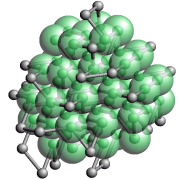

Simplified protein models are coarse-grained representations of proteins. They allow for performing large-scale studies in silico in order to analyze features of protein-like systems. The main attractivity of such models is that they are still computationally manageable in situations where the use of more complex models is completely out of computational reach.
Nevertheless, for the aim of structure prediction of real proteins, well-designed protein models with a reasonable balance of complexity and detail can also provide candidates for further refinement.
Recent studies of protein evolution, thermodynamical, and kinetic aspects of proteins were still strongly restricted to very simple (often 2-dimensional) protein models. Our approaches to protein structure prediction in 3-dimensional protein models have vastly improved the complexity of protein models that can be reasonably used in large-scale computational studies.
In this research area, we are interested in constraint-based techniques for the prediction of optimal protein structures in lattice protein models with strong hydrophobic energy contribution. We solved the protein structure prediction problem for models on the cubic lattice and on the much more complex face-centered cubic lattice.
Furthermore, we are interested in all kinds of applications that are enabled by our key technology of structure prediction. For example, we analyze the sequence-structure mapping for a better understanding of protein evolution or construct energy landscapes for finally investigating protein kinetics.

Here, we develop methods to predict the spatial structure of simplified proteins in HP-type models on the cubic and face-centered cubic (FCC) lattice. These models are extensions of Ken Dill’s HP-model. Using FCC instead of only the three-dimensional cubic lattice or even two-dimensional lattices is a significant advance, since this lattice can model real proteins rather accurately and lacks the so-called parity problem of cubic lattices.
We are still interested in improvements, either in terms of model complexity or of prediction efficiency.
We have developed and implemented constrained-based methods for prediction in HP and HPNX models on the cubic and face-centered cubic lattice.
In our implementations, we use advanced constraint-techniques, e.g., general symmetry breaking à la Backofen/Will.
Martin Mann, Cameron Smith, Mohamad Rabbath, Marlien Edwards, Sebastian Will, and Rolf Backofen. CPSP-web-tool : a server for 3D lattice protein studies. Bioinformatics, 2009.
Martin Mann, Daniel Maticzka, Rhodri Saunders, and Rolf Backofen. Classifying protein-like sequences in arbitrary lattice protein models using LatPack. HFSP Journal, 2 no. 6 pp. 396, 2008. Supplementary data can be obtained HERE.
Martin Mann, Sebastian Will, and Rolf Backofen. CPSP-tools - Exact and Complete Algorithms for High-throughput 3D Lattice Protein Studies. BMC Bioinformatics, 9, 230, 2008.
Sebastian Will and Martin Mann. Counting protein structures by dfs with dynamic decomposition. Proc. of the Workshop on Constraint Based Methods for Bioinformatics, page 6, 2006.
Rolf Backofen and Sebastian Will. A constraint-based approach to fast and exact structure prediction in three-dimensional protein models. Journal of Constraints, 11 no. 1 pp. 5-30, January 2006.
Sebastian Will. Constraint-based hydrophobic core construction for protein structure prediction in the face-centered-cubic lattice. Proceedings of the Pacific Symposium on Biocomputing 2002 (PSB 2002), pages 661-672, Singapore, 2002. World Scientific Publishing Co. Pte. Ltd.
Rolf Backofen and Sebastian Will. Fast, constraint-based threading of HP-sequences to hydrophobic cores. Proceedings of 7th International Conference on Principle and Practice of Constraint Programming (CP’2001), volume 2239 of Lecture Notes in Computer Science, pages 494-508, Berlin, 2001. Springer-Verlag.
Rolf Backofen and Sebastian Will. Optimally compact finite sphere packings – hydrophobic cores in the FCC. Proc. of the 12th Annual Symposium on Combinatorial Pattern Matching (CPM2001), volume 2089 of Lecture Notes in Computer Science, pages 257-272, Berlin, 2001. Springer-Verlag.